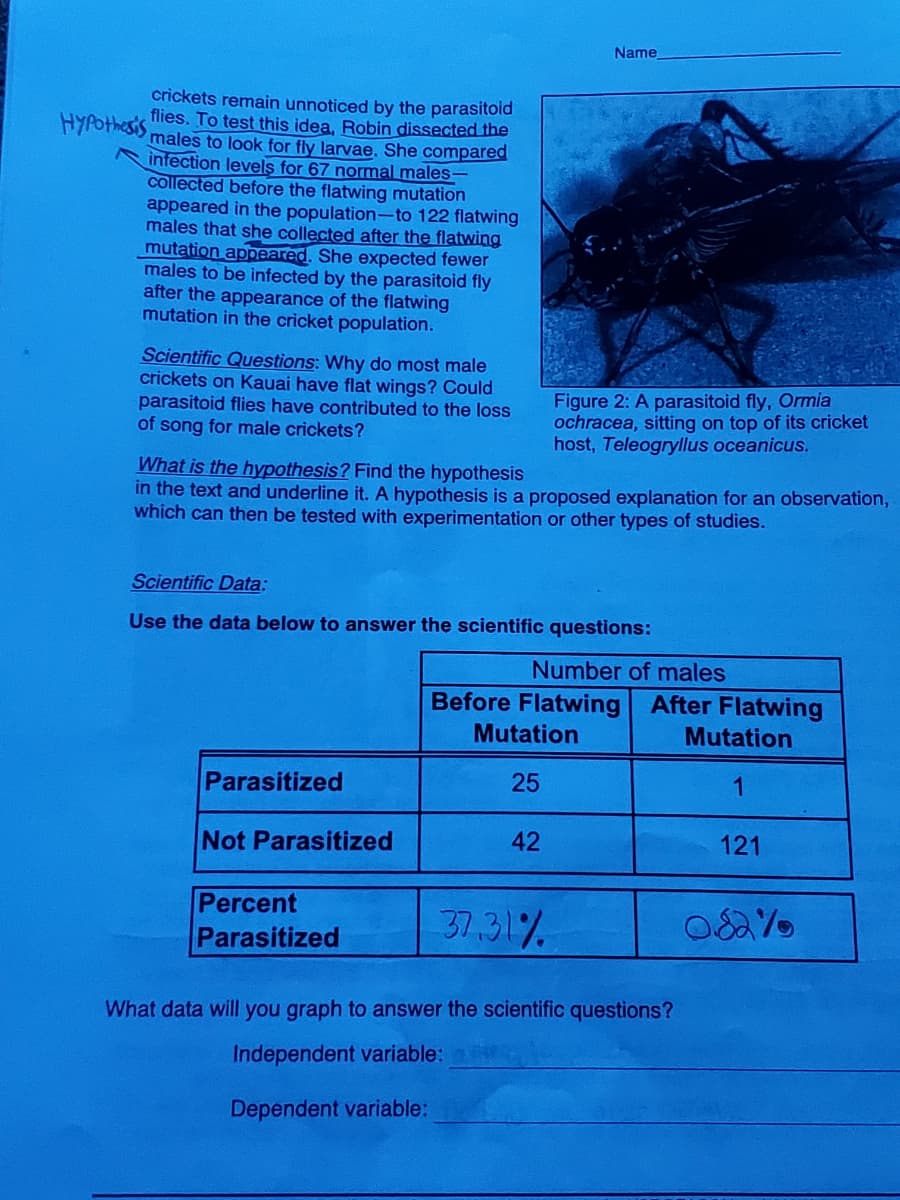Scientific Questions: Why do most male crickets on Kauai have flat wings? Could parasitoid flies have contributed to the loss of song for male crickets? Figure 2: A parasitoid fly, Ormia ochracea, sitting on top of its cricket host, Teleogryllus oceanicus. What is the hypothesis? Find the hypothesis in the text and underline it. A hypothesis is a proposed explanation for an observation, which can then be tested with experimentation or other types of studies. Scientific Data: Use the data below to answer the scientific questions: Number of males Before Flatwing After Flatwing Mutation Mutation Parasitized 25 1 Not Parasitized 42 121 Percent Parasitized 37.31% What data will you graph to answer the scientific questions? Independent variable: Dependent variable:
Scientific Questions: Why do most male crickets on Kauai have flat wings? Could parasitoid flies have contributed to the loss of song for male crickets? Figure 2: A parasitoid fly, Ormia ochracea, sitting on top of its cricket host, Teleogryllus oceanicus. What is the hypothesis? Find the hypothesis in the text and underline it. A hypothesis is a proposed explanation for an observation, which can then be tested with experimentation or other types of studies. Scientific Data: Use the data below to answer the scientific questions: Number of males Before Flatwing After Flatwing Mutation Mutation Parasitized 25 1 Not Parasitized 42 121 Percent Parasitized 37.31% What data will you graph to answer the scientific questions? Independent variable: Dependent variable:
Biology Today and Tomorrow without Physiology (MindTap Course List)
5th Edition
ISBN:9781305117396
Author:Cecie Starr, Christine Evers, Lisa Starr
Publisher:Cecie Starr, Christine Evers, Lisa Starr
Chapter15: Animal Evolution
Section: Chapter Questions
Problem 1CT
Related questions
Question
100%

Transcribed Image Text:Name
crickets remain unnoticed by the parasitoid
flies. To test this idea, Robin dissected the
otS males to look for fly larvae. She compared
A infection levels for 67 normal males-
collected before the flatwing mutation
appeared in the population-to 122 flatwing
males that she collected after the flatwing
mutation appeared. She expected fewer
males to be infected by the parasitoid fly
after the appearance of the flatwing
mutation in the cricket population.
Scientific Questions: Why do most male
crickets on Kauai have flat wings? Could
parasitoid flies have contributed to the loss
of song for male crickets?
Figure 2: A parasitoid fly, Ormia
ochracea, sitting on top of its cricket
host, Teleogryllus oceanicus.
What is the hypothesis? Find the hypothesis
in the text and underline it. A hypothesis is a proposed explanation for an observation,
which can then be tested with experimentation or other types of studies.
Scientific Data:
Use the data below to answer the scientific questions:
Number of males
Before Flatwing After Flatwing
Mutation
Mutation
Parasitized
25
1
Not Parasitized
42
121
Percent
Parasitized
37.31%
What data will you graph to answer the scientific questions?
Independent variable:
Dependent variable:
Expert Solution
This question has been solved!
Explore an expertly crafted, step-by-step solution for a thorough understanding of key concepts.
This is a popular solution!
Trending now
This is a popular solution!
Step by step
Solved in 3 steps

Knowledge Booster
Learn more about
Need a deep-dive on the concept behind this application? Look no further. Learn more about this topic, biology and related others by exploring similar questions and additional content below.Recommended textbooks for you

Biology Today and Tomorrow without Physiology (Mi…
Biology
ISBN:
9781305117396
Author:
Cecie Starr, Christine Evers, Lisa Starr
Publisher:
Cengage Learning

Biology Today and Tomorrow without Physiology (Mi…
Biology
ISBN:
9781305117396
Author:
Cecie Starr, Christine Evers, Lisa Starr
Publisher:
Cengage Learning